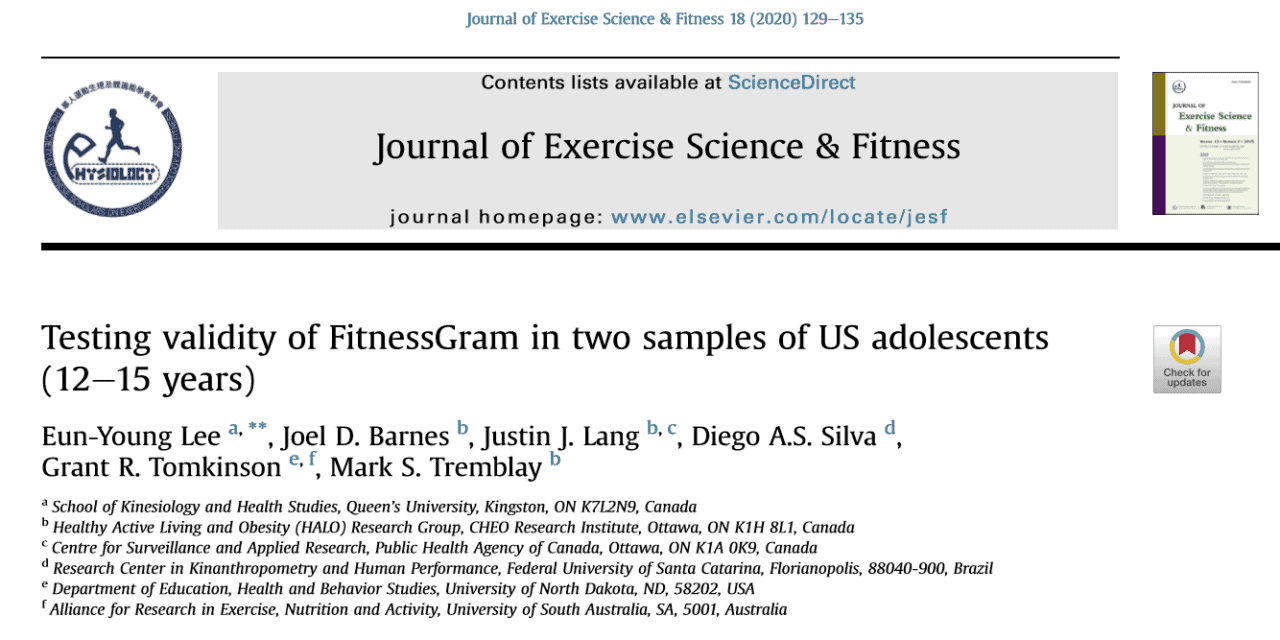A group of HALO alumni and HALO Director Dr. Mark Tremblay recently published a paper titled “Testing validity of FitnessGram in two samples of US adolescents (12–15 years)” in the Journal of Exercise Science and Fitness. Congratulations! Citation details and a summary of the paper are below.
Lee, E.-Y., Barnes, J. D., Lang, J. J., Silva, D. A., Tomkinson, G. R., & Tremblay, M. S. (2020). Testing validity of FitnessGram in two samples of US adolescents (12–15 years). Journal of Exercise Science & Fitness, 18(3), 129–135. doi: 10.1016/j.jesf.2020.04.002
Abstract
Background: This study examined the validity of the FitnessGram® criterion-reference cut-points for cardiorespiratory fitness (CRF) based on two samples of US adolescents (aged 12–15 years). This study also established the CRF cut-points for metabolically healthy weight status based on a recent national fitness survey for the purposes of cross-validating with pre-existing cut-points including FitnessGram.
Methods: Two cross-sectional data from the 2003–2004 National Health and Nutrition Examination Survey (NHANES) (n = 378) and 2012 NHANES National Youth Fitness Survey (NNYFS) (n = 451) were used. CRF (estimated V˙O2max in mL/kg/min) was estimated from a submaximal exercise test. CRF categories based on FitnessGram cut-points, a clustered cardiometabolic risk factors score and weight status were used. A series of Receiver Operating Characteristic (ROC) curve analyses were conducted to identify age- and sex-specific CRF cut-points that were optimal for metabolically healthy weight status.
Results: Based on FitnessGram cut-points, having high risk CRF, but not low risk CRF, was associated with high cardiometabolic risk (OR = 3.17, 95% CI = 1.14–8.79) and unhealthy weight status (OR = 5.81, 95% CI = 3.49–9.68). The optimal CRF cut-points for 12-13-year-olds and 14-15-year-olds were 40 and 43 mL/kg/min in males and 39 and 34 mL/kg/min in females, respectively. Compared to meeting new CRF cut-points, not meeting new CRF cut-points was associated with higher odds of showing high cardiometabolic risk (OR = 2.91, 95% CI = 1.47–5.77) and metabolically unhealthy weight status (OR = 4.47, 95% CI = 2.83–7.05).
Conclusion: FitnessGram CRF cut-point itself has rarely been scrutinized in previous literature. Our findings provide partial support for FitnessGram based on two samples of US adolescents. CRF cut-points established in this study supports international criterion-referenced cut-points as well as FitnessGram cut-points only for males. FitnessGram should be continuously monitored and scrutinized using different samples
The full article is available here.





